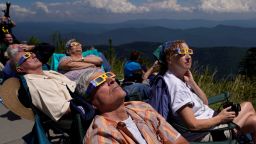Sign up for CNN’s Wonder Theory science newsletter. Explore the universe with news on fascinating discoveries, scientific advancements and more.
On Saturday, a celestial spectacle will occur over North, Central and South America as an annular solar eclipse creates a “ring of fire” in the sky.
Annular solar eclipses are like total solar eclipses, except the moon is at the farthest point in its orbit from Earth, so it can’t completely block the sun. Instead, the sun’s fiery light surrounds the moon’s shadow, creating the so-called ring of fire.
And you don’t want to miss the chance to see this scintillating event — an annular eclipse won’t appear over this part of the world again until 2046, according to NASA.
“It is like nothing you’ve ever experienced before,” said Mitzi Adams, assistant chief of the Heliophysics and Planetary Science Branch at NASA’s Marshall Space Flight Center, in a statement. “It’s sort of like somebody puts a bowl on top of Earth right above where you’re standing. In the middle of the day, it gets darker, but you can still see light around the rim.”
What time is the annular solar eclipse?
The annular solar eclipse will begin in the United States at 9:13 a.m. PT (12:13 p.m. ET) and pass from Oregon to the Gulf Coast in Texas, appearing in Nevada, Utah and New Mexico along the way as well. The event will also be visible in parts of California, Idaho, Colorado and Arizona. It will end in the US at 12:03 p.m. CT (1:03 p.m. ET).
After leaving the US, the eclipse will cross Mexico, Belize, Honduras, Panama and Colombia before ending off South America’s Atlantic coast at Natal, Brazil.

Weather permitting, a crescent-shaped partial solar eclipse, where only part of the sun is covered by the moon, will be visible in all 49 continental US states, including Alaska, according to NASA. Check the Great American Eclipse website and TimeandDate.com to see when the eclipse will be in your area and what you’ll be able to see.
Unable to see the eclipse in person? NASA will host a live stream beginning at 11:30 a.m. ET on eclipse day, sharing views from Albuquerque, New Mexico; Kerrville, Texas; and White Sands, New Mexico, according to Kelly Korreck, eclipse program manager at NASA.
What to see
Those in the path of the annular eclipse will experience several phases of the event. First, as the moon begins to pass in front of the sun, it will create a crescent-shaped partial eclipse, making it look like the moon is taking a bite out of our star.
An hour and 20 minutes after the partial eclipse begins, the moon will move directly in front of the sun, creating the ring of fire (also called annularity). Depending on your location along the path, this phase will last between one and five minutes.
During annularity, the sky will grow darker, though not as dark as during a total solar eclipse, when all the sun’s light is blocked. Animals may behave like they do at dusk, and the air may feel cooler, according to NASA.
The moon will continue its trek across the sun for another hour and 20 minutes, creating another partial eclipse, before the moon moves out of sight.
How to safely watch the annular solar eclipse
It’s never safe to look directly at the sun without using specialized protection, and there is no phase of an annular or partial eclipse that is safe to view with the naked eye because the sun’s light is never completely blocked.
To view the annular eclipse safely, wear certified ISO 12312-2 compliant solar eclipse glasses or use a handheld solar viewer. Separately, you can observe the sun with a telescope, binoculars or camera that has a special solar filter on the front, which acts the same way eclipse glasses would.
Don’t look at the sun through any optical device — cameras lens, telescope, binoculars — while wearing eclipse glasses or using a handheld solar viewer, according to NASA. Solar rays can still burn through the filter on the glasses or viewer, given how concentrated they can be through an optical device, and can cause severe eye damage.

If you normally wear eyeglasses, keep them on and put eclipse glasses over them or hold a handheld viewer in front of them, according to the American Astronomical Society.
Put on your eclipse glasses before looking up and remember to turn away from the sun before you remove them again.
Always keep an eye on any children wearing eclipse glasses to make sure they don’t remove them while looking at the sun.
Sunglasses won’t work in place of eclipse glasses or solar viewers, which are 100,000 times darker and held to an international standard. Don’t use torn, scratched or damaged eclipse glasses or solar viewers.
For safe manufacturers and resellers of eclipse glasses and filters for optical devices, including cameras and smartphones, check out the list curated by the American Astronomical Society.
Indirectly watch the eclipse
Eclipses can also be viewed indirectly using a pinhole projector, such as a hole punched through an index card. The proper way to use these is by standing with your back to the sun and holding up the card. The pinhole projects an image of the sun on the ground or other surfaces. But never face the sun while viewing it this way and don’t look directly at it through the pinhole.
Other pinhole projectors you may already have on hand include colanders, straw hats or anything with small holes in it. The small holes will reflect the sun’s crescent during a partial eclipse or a ring during the annular eclipse.
Photographing the eclipse
Want to capture your eclipse memories through photos? After ensuring your camera has a protective solar filter, don’t forget to grab a tripod to prevent your image of the ring of fire from being blurry as the skies darken.
Manually focusing your camera and changing your exposure can help with the darkness as it descends during the event, according to NASA. The American Astronomical Society also has tips for anyone wishing to capture images or video of the annular eclipse.
While all eyes will be on the eclipse happening above, take in your surroundings as well, noting the unusually dark landscape and shadows created by the eclipse. Standing by a leafy tree? The small spaces between leaves will dapple patterns of the eclipse phase on the ground, which makes for a great shot.
“The real pictures are going to be of the people around you pointing, gawking, and watching it,” NASA photographer Bill Ingalls said in a statement. “Those are going to be some great moments to capture to show the emotion of the whole thing.”







